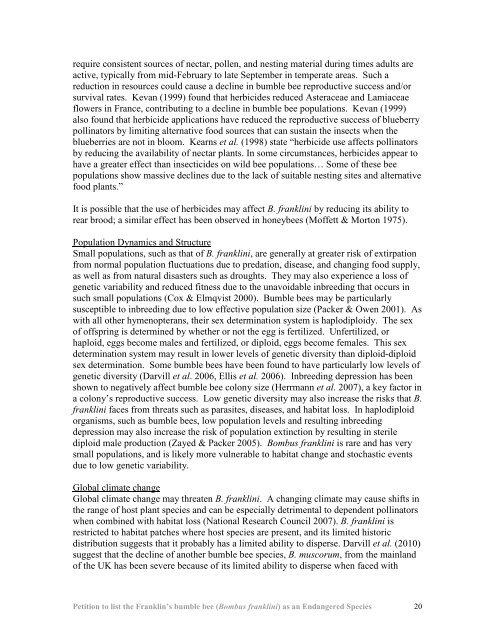Franklin's bumble bee - The Xerces Society
Franklin's bumble bee - The Xerces Society
Franklin's bumble bee - The Xerces Society
You also want an ePaper? Increase the reach of your titles
YUMPU automatically turns print PDFs into web optimized ePapers that Google loves.
equire consistent sources of nectar, pollen, and nesting material during times adults are<br />
active, typically from mid-February to late September in temperate areas. Such a<br />
reduction in resources could cause a decline in <strong>bumble</strong> <strong>bee</strong> reproductive success and/or<br />
survival rates. Kevan (1999) found that herbicides reduced Asteraceae and Lamiaceae<br />
flowers in France, contributing to a decline in <strong>bumble</strong> <strong>bee</strong> populations. Kevan (1999)<br />
also found that herbicide applications have reduced the reproductive success of blueberry<br />
pollinators by limiting alternative food sources that can sustain the insects when the<br />
blueberries are not in bloom. Kearns et al. (1998) state “herbicide use affects pollinators<br />
by reducing the availability of nectar plants. In some circumstances, herbicides appear to<br />
have a greater effect than insecticides on wild <strong>bee</strong> populations… Some of these <strong>bee</strong><br />
populations show massive declines due to the lack of suitable nesting sites and alternative<br />
food plants.”<br />
It is possible that the use of herbicides may affect B. franklini by reducing its ability to<br />
rear brood; a similar effect has <strong>bee</strong>n observed in honey<strong>bee</strong>s (Moffett & Morton 1975).<br />
Population Dynamics and Structure<br />
Small populations, such as that of B. franklini, are generally at greater risk of extirpation<br />
from normal population fluctuations due to predation, disease, and changing food supply,<br />
as well as from natural disasters such as droughts. <strong>The</strong>y may also experience a loss of<br />
genetic variability and reduced fitness due to the unavoidable inbreeding that occurs in<br />
such small populations (Cox & Elmqvist 2000). Bumble <strong>bee</strong>s may be particularly<br />
susceptible to inbreeding due to low effective population size (Packer & Owen 2001). As<br />
with all other hymenopterans, their sex determination system is haplodiploidy. <strong>The</strong> sex<br />
of offspring is determined by whether or not the egg is fertilized. Unfertilized, or<br />
haploid, eggs become males and fertilized, or diploid, eggs become females. This sex<br />
determination system may result in lower levels of genetic diversity than diploid-diploid<br />
sex determination. Some <strong>bumble</strong> <strong>bee</strong>s have <strong>bee</strong>n found to have particularly low levels of<br />
genetic diversity (Darvill et al. 2006, Ellis et al. 2006). Inbreeding depression has <strong>bee</strong>n<br />
shown to negatively affect <strong>bumble</strong> <strong>bee</strong> colony size (Herrmann et al. 2007), a key factor in<br />
a colony’s reproductive success. Low genetic diversity may also increase the risks that B.<br />
franklini faces from threats such as parasites, diseases, and habitat loss. In haplodiploid<br />
organisms, such as <strong>bumble</strong> <strong>bee</strong>s, low population levels and resulting inbreeding<br />
depression may also increase the risk of population extinction by resulting in sterile<br />
diploid male production (Zayed & Packer 2005). Bombus franklini is rare and has very<br />
small populations, and is likely more vulnerable to habitat change and stochastic events<br />
due to low genetic variability.<br />
Global climate change<br />
Global climate change may threaten B. franklini. A changing climate may cause shifts in<br />
the range of host plant species and can be especially detrimental to dependent pollinators<br />
when combined with habitat loss (National Research Council 2007). B. franklini is<br />
restricted to habitat patches where host species are present, and its limited historic<br />
distribution suggests that it probably has a limited ability to disperse. Darvill et al. (2010)<br />
suggest that the decline of another <strong>bumble</strong> <strong>bee</strong> species, B. muscorum, from the mainland<br />
of the UK has <strong>bee</strong>n severe because of its limited ability to disperse when faced with<br />
Petition to list the Franklin’s <strong>bumble</strong> <strong>bee</strong> (Bombus franklini) as an Endangered Species 20
















